
For the class I'm taking on joggles.com, I created these color studies. I cut one-inch squares of colors from magazines, and then sorted and glued them to the pages in my studio journal. I'm not sure why, but I found this immensely fun and terribly addictive. "Yes, it is near midnight, and I really need to go to bed, but I have to find that illusive shade of chartreuse I have seen only in my dreams..."
I took the materials for this exercise to my parents' house, where I was staying for a few days with my children, and ended up leaving my creative mess all over my parents' kitchen table for a long periods.
Before I set up my studio (by staking out and then commandeering the guest room), this is how I worked, and why it was so hard to get anything done. You need space to do this kind of work, or at least I do. You have to have a place to work, and then leave everything for a while... either to gestate, or to accumulate dust. This is something that not everyone understands. And frankly, it would drive me crazy, too, especially when an important art project was taking up the same kitchen counter I needed to chop vegetables for dinner.
As the mother of young children who also wears several other hats (graphic designer, artist, quilt pattern designer, volunteer, housekeeper, cook, chauffeur...), I do a lot of juggling. Well, maybe juggling is not quite the word. It's more like throwing something into the air, catching it, and then putting it down on the floor, so that I can throw and catch the next forty-two balls and then put them down to go back to ball number one. Or at least that is what it feels like most of the time.
I try not to drop the balls. But I'm a realist: I know I can't keep all of them in the air at the same time. So I try to catch them carefully and put them down in a safe place until they demand to be thrown back up. Some of them sit around for a long time. My studio is a safe place for them to wait.
Doing this project outside my studio reminded me how terribly thankful I am to have this studio space, this room of my own* to do my thing.
Photos of the other color studies follow below. One interesting note: there were some colors that were harder to find, or harder to find with interesting textures in them. Yellow was the most difficult. WHY? It just doesn't seem to be a popular color right now. And in most cases, it was a flat yellow (panels of a single yellow shade, rather than photos of objects with texture). Hmmmm... have to think more about that.





* Virginia Woolf (1882-1941) was an English author, feminist, essayist, publisher, and critic. In her 1929 book,
A Room of One’s Own, she wrote:
All I could do was to offer you an opinion upon one minor point—a woman must have money and a room of her own if she is to write fiction; and that, as you will see, leaves the great problem of the true nature of woman and the true nature of fiction unsolved.






























































